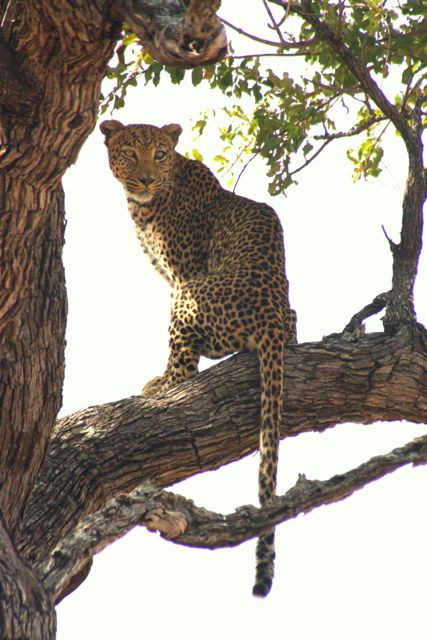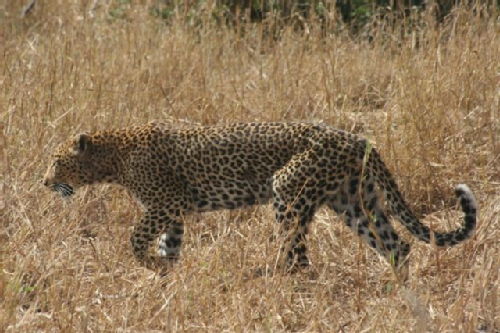All 108 entries tagged Travel Writing
View all 115 entries tagged Travel Writing on Warwick Blogs | View entries tagged Travel Writing at Technorati | View all 66 images tagged Travel Writing
May 11, 2016
Le Port–Museé, Douarnenez, Finistère, Brittany
Writing about web page http://www.port-musee.org
Douarnenez is a small town on the coast in the bottom corner of the bay that stretches out towards the Crozon in the north and Cap Sizun and Pointe de Raz to the west. Finistère does of course mean "the end of the land" - but for many Bretons now and in the past, with their love of the sea, it really means "the start of the ocean". Douarnenez is, these days, as much about beaches, cafés and coastal wildlife as it is about real oceanic adventures. But its two ports are still busy with leisure and historic craft, as well as a few working boats. You can even buy Douarnenez sardines in Waitrose.

But in addition the town has put some effort into maintaining its link with the sea. There is an annual tall ship festival. And you can learn to sail or kayak. But most of all there is a really wonderful museum full of maritime character and the smell of ancient salty timbers.
For the last few years Le Port-Museé has been one of my favourite places to visit with my children. It has been magical for them and for us adults too. We keep going back. And there is plenty of reason to do so. The museum fills cavernous old warehouses and a long stretch of the river (the old port Rhu). There are permanent exhibitions, with a wide selection of old boats and associated clothes and equipment, all displayed with great thought and arranged for visual and learning impact. The musuem also hosts large "temporary" exhibitions (although they do seem to stay for a couple of years). We have seen The Box (about the container shipping business) - which might sound dull, but is in fact brilliantly done with amazing exhibits including a giant lego model of a container port. We have also visited the Sinbad exhibition, about the maritime traditions of Arabia, which is still running. It is wonderful. They even sailed a dhow called Nizwa all the way from Oman - we have seen it sailing out across the bay, which is quite surprising when in close up you see just how roughly made it is.
There are many ships into which you can explore, with all decks open - lots of them on moored on the river, but also (and this is the most popular with the children) a fishing boat in the warehouse on which they can play at being at sea.
There is a lot more to the place than I have so far described. To really get across how great it is, here are some photos from our visits over two years.
Steering hard to starboard...

Full steam ahead for the Mighty Atom!

The Nizwa dhow, all the way from Oman and now sailing across the Bay of Douarnenez.

Ghostly sailor's clothes...


A life-size diorama of an old Breton port...

Fish people!

The huge lego model of a container port...

One of the many Arabian artefacts in the Sinbad exhibition. There is also a recreation of a Omani house, including spices, and a giant Arab astrological map.

And there is a great restaurant next door.

August 11, 2009
Child sentenced to Robben Island style hard labour
Follow-up to Robert gets his head smashed in Dorset from Transversality - Robert O'Toole
For his part in the brutal murder of Robert the Crab, Lawrence O'Toole (almost 4) was sentenced to a life of hard labour smashing rocks in the West Dorset ammonite mines. Lawrence was heard to comment: "this is well cool, just like Nelson Mandela, crime really rocks".

The campus police man was not amused at having to fruitlessly patrol an entirely harmless gathering of motorcylists in the Warwickshire countryside, while such outlaws roamed the land, perpetrating acts of unspeakable cruelty on defenceless crustacea.

August 10, 2009
Robert gets his head smashed in Dorset
Children can be just so cruel. Especially Lawrence. Early on Friday morning we set off to Samway's, the West Bay fish monger, just around the corner from our apartment on the cliff top at Burton Bradstock, Dorset. The boy refused lobster, aiming his hammer at the most substantial target on offer: a 12 inch wide crab, complete with fearsome pincers. We returned home, I struggling under the weight of several kilos of sea food: the giant crab, a large skate, a smaller haddock, and a bag full of samphire.
Back in the kitchen, Lawrence was keen to get the crab out of its bag and start to pursue innocent squeeling ladies with its snapping pincers and pungent aroma. Emma was unimpressed. Eventually we deposited the crab in the fridge, by which time it was no longer merely "the crab", Lawrence having chosen a name for his deceased crustacea. For some inexplicable reason, the crab was called "Robert". Thanks Lawrence.

And so when finally the ominous mallet of supper-time hovered meanacingly over the prettily orange speckled carapace of fate, many jokes had been tossed into the boulabaise of family banter.
SMASH.
A crushing blow landed square in the center of Robert's head.
He crumpled beneath its shattering force, light splurges of gungy brown meat leaking out on the rebound.

Health and safety tip: always wear protective goggles when smashing a crab.
Teasing away a splintered fragment of shell, the intrepid culinary adventurers revealed the false dawn that is the body of the crab. Insubstantial but tasty. The carapace contains only brown sludge. Delicious brown sludge. I led Lawrence to believe it to be the crab's brain. Not sure if that is true or false, but it's a good story.
A mopping-up operation then commenced, us armed with chunks of good white bread sourced from Bridport's marvellous Washingpool Farm Shop.
And then onto the hard-core crab eating: chunky white leg meat, the extraction of which required heavier artillery - Lawrence's geology hammer delivered just the necessary impacts (with the crab now placed on the ground for maximum ballistic intent).
Eventually, it lay before us thoroughly exhausted and extinct. Only a single claw remained intact, providing hours of cheap entertainment for everyone, especially Lawrence.

Apparently, the skate (roasted), haddock (fried), and samphire (boiled) were also of excellent standing.
Well done to Samway's and to Washingpool.
Sorry Robert the crab.
June 12, 2009
Asturias rocks
Follow-up to A short walk in Asturias from Transversality - Robert O'Toole
Pleistocene cave bears discovered living on the Asturian coast...
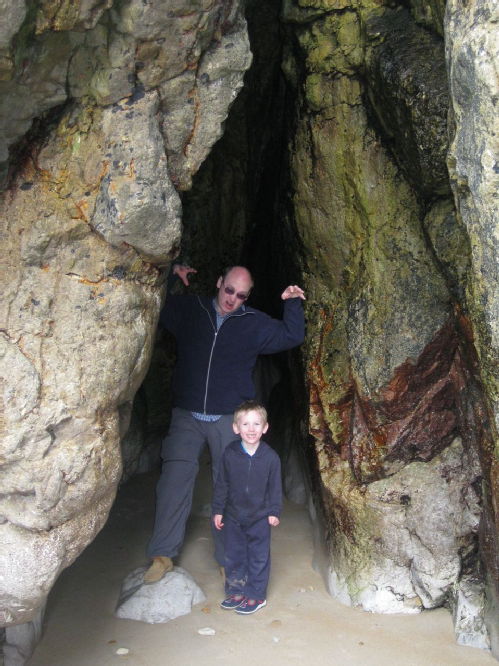
If you like limestone, you'll love Asturias...

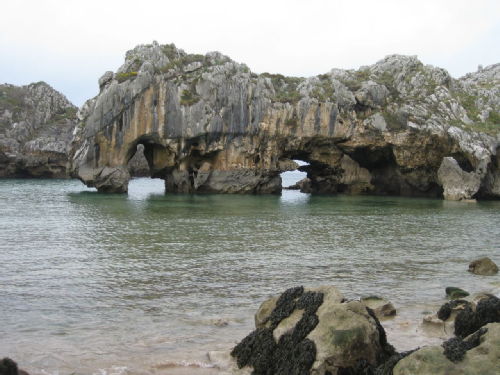
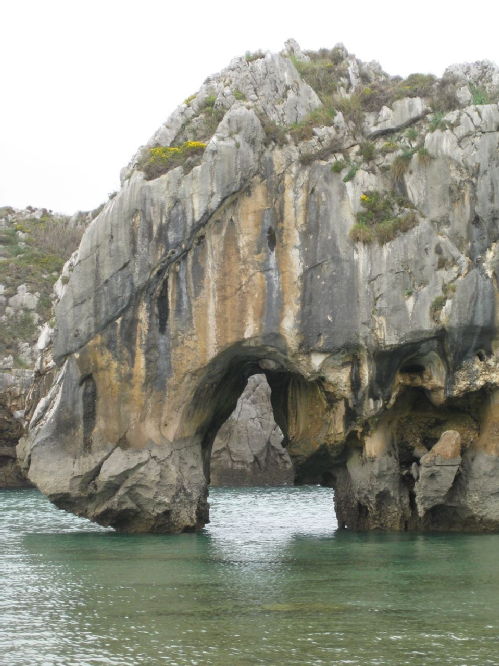

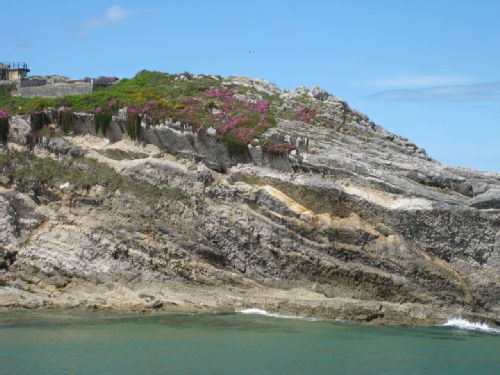
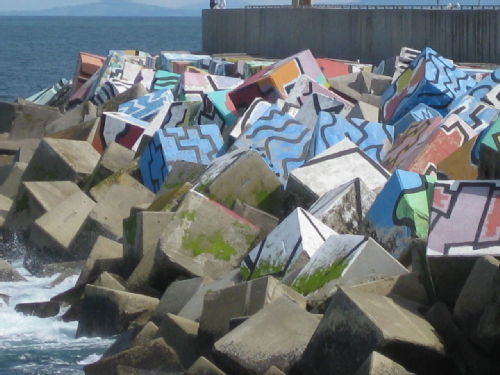
Art.
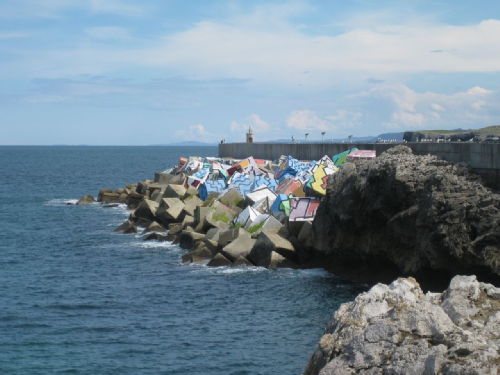
June 11, 2009
A short walk in Asturias
Follow-up to Ribadesella, Asturias from Transversality - Robert O'Toole
Sand lizards basking on a rock near to the edge of Poo de Llanes. Too fast for Lawrence to catch.

Finding interesting insects on the long-distance coastal path.

A small river runs out of the mountains and down to the sea. We followed its course.

Spring wild flowers.

Along the river.

A shoal of fish. Lawrence wanted to jump in and catch them (in the style of Nigel Marven).

The river bed widens out into a cove.

And down towards the sea.

June 01, 2009
Ribadesella, Asturias
Follow-up to Funicular de Bulnes, Picos de Europa, Asturias from Transversality - Robert O'Toole
The Rio Sella cascades down from the Picos de Europa, quickly losing its momentum, and flowing out into the Bay of Biscay at the smart sea side resort of Ribadesella.
On several occasions we drove the short distance along the twisty coast road from Llanes, for drinks and food at the elegant Pastelería-Bombonería Nerian.
Ribadesella's long beach:

Just like Baywatch:

Lawrence always finds interesting material for a beach sculpture:

The Hotel Villarosario is one of many elegant buildings:

Towns and villages in Asturias usually have a new play area:

The play area is next to a lagoon with a series of bird hides. We spotted a citrine warbler in the trees.

ThePastelería-Bombonería Nerian serves great pizza, hambuergesas, and an amazing selection of confections:




May 20, 2009
Funicular de Bulnes, Picos de Europa, Asturias
Follow-up to El Museo Jurásico de Asturias from Transversality - Robert O'Toole
From our house in Poo de Llanes, Asturias, we could look South towards the Picos de Europa range. I had ridden through the mountains with Martin a couple of years ago, and wanted to take Emma and Lawrence to see the mountains, streams, meadows and eagles.
We drove down to the Arenas de Cabrales for coffee and tortilla. Here's a photo from the Garganta de Cares (gorge of the river Cares) to the East of Arenas:

Steep meadows fill the valleys:

The road winds along the river:

A grain store, typical of Asturias. Traditional farming practices are common throughout:

Boarding the Funicular de Bulnes train, which travels 2km underneath a mountain, up to mountain village:

At the other end of the tunnel, we walked along a remote mountain foot path.

Fishing in a mountain stream:

Goats, just like those in Lawrence's herd in Africa:

A view across to the peak of Naranjo de Bulnes, still covered in snow at Easter. As we looked out to the mountain, many large raptors drifted by on a thermal: Golden Eagles & Griffon Vultures.
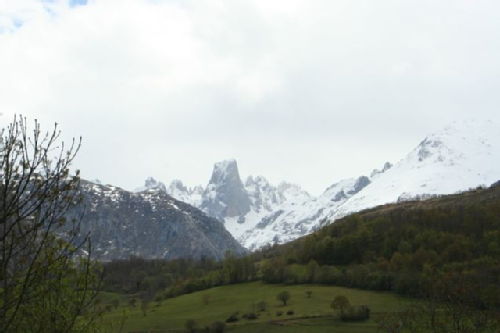
May 18, 2009
El Museo Jurásico de Asturias
Follow-up to Poo de Llanes beach, Asturias from Transversality - Robert O'Toole
Near to Colunga on the Asturian 'jurassic coast', MUJA is an amazing museum full of fossils, reconstructions, and informative displays. It is built in the shape of a giant foot print, with each toe representing a different part of the Mesozoic, along with some Permian and Tertiary exhibits to put them into context.
It's a great place to hear a lecture by a leading palaeontologist:

Some of the exhibits can get quite hungry, best appease them with sacrificial children:

This photo gives an idea of the vast size of the halls:

Lawrence correctly identified the oviraptor and explained its name (egg eating raptor):

A display illustrating possible colour schemes for various Ceratopsidae.

May 17, 2009
Poo de Llanes beach, Asturias
Follow-up to Asturias again from Transversality - Robert O'Toole
This image from Google Maps shows the lagoon at Poo de Llanes, in Asturias. You can see how it has three parts: the shallow lagoon, a second sandy lagoon that fills up with water at high tide, and a creek with a river leading into the lagoon. Our house for the week in Asturias was in the village just at the bottom left of the picture, with a short walk down to the sea.

The house:
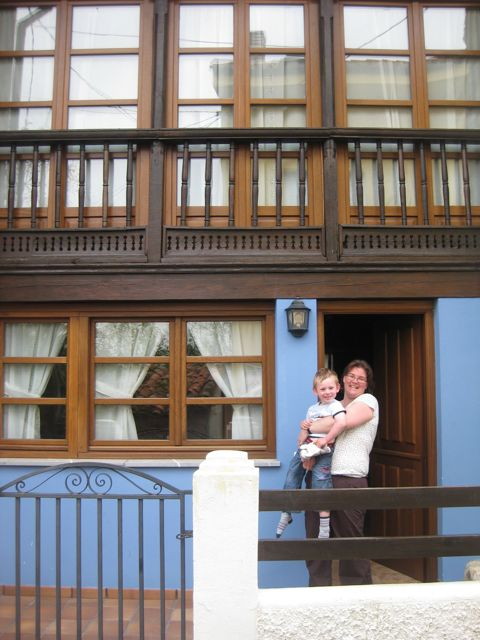
Countryside behind the house, looking towards the foothills of the Picos de Europa.
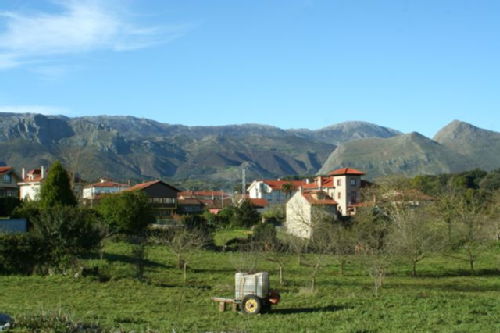
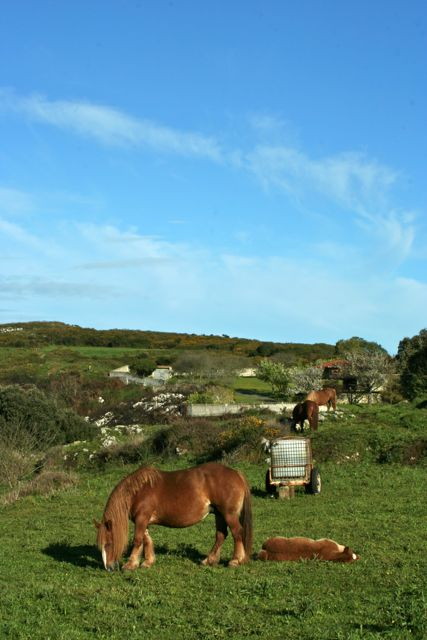
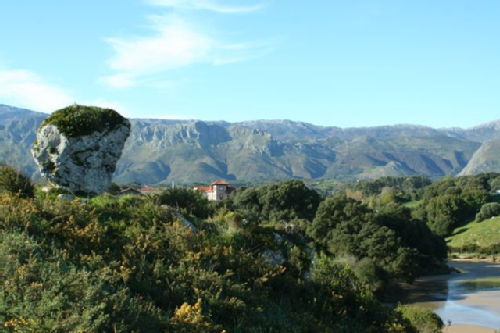
Looking towards the creek.
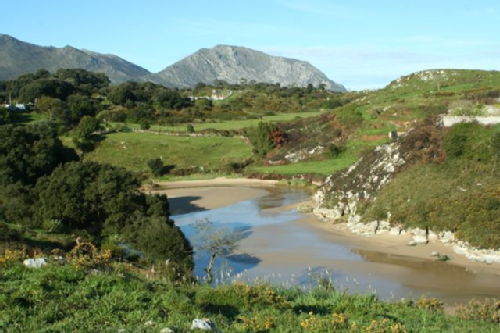
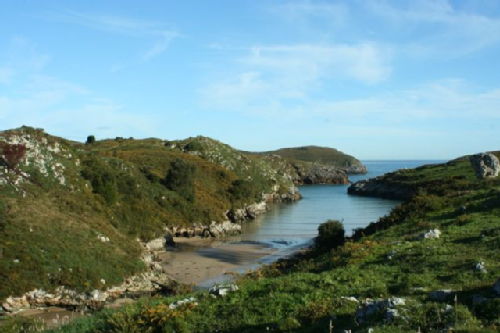
Looking towards the sea.

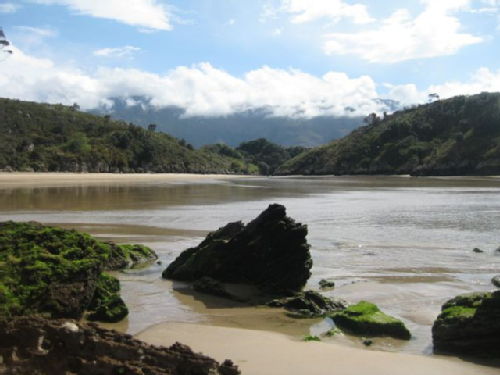
Mountain weather in one direction, blue sea and sky in the other.
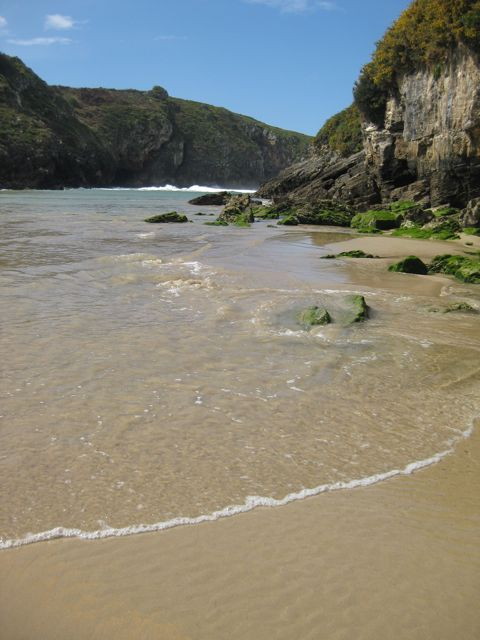
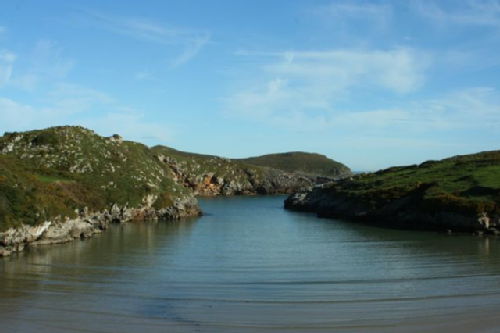
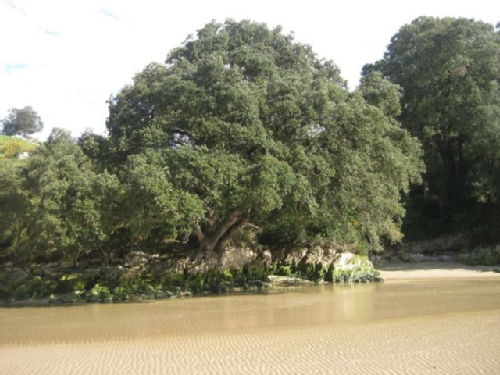
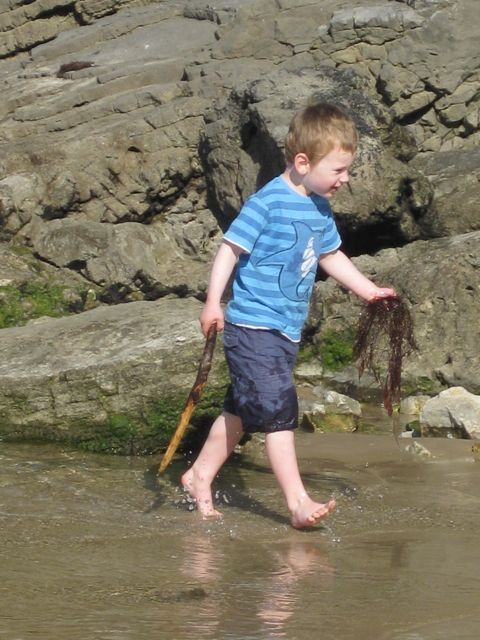
Wading across the lagoon to a sea cave.
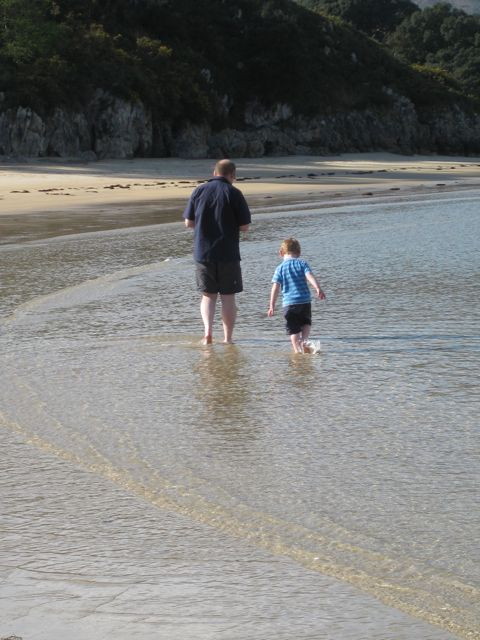

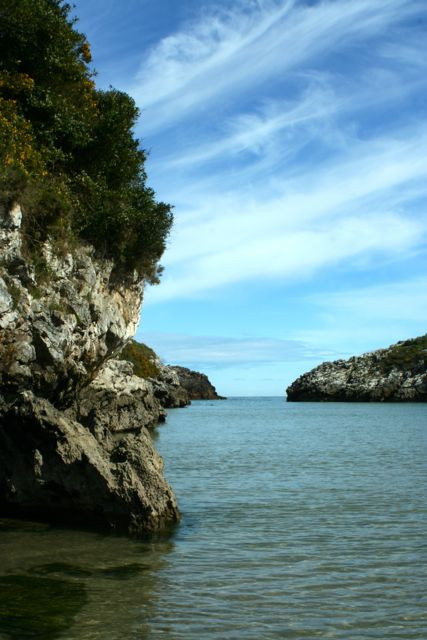
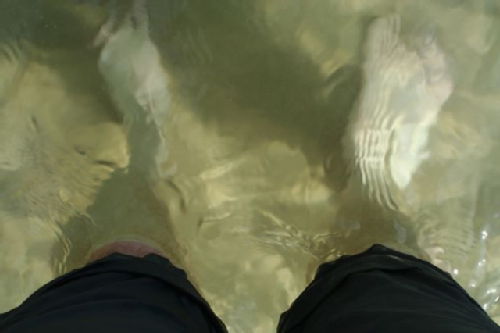
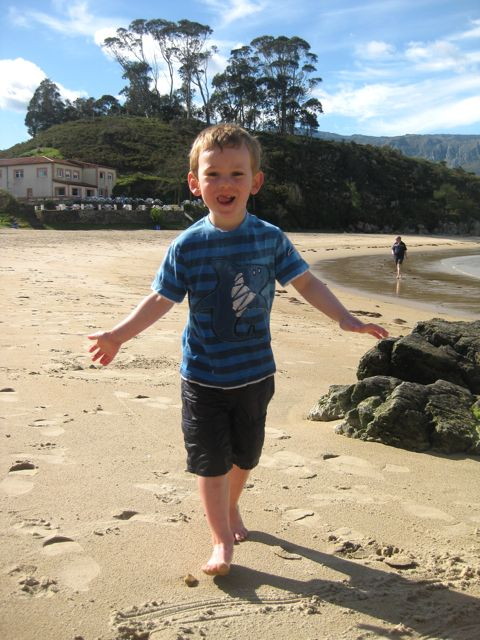
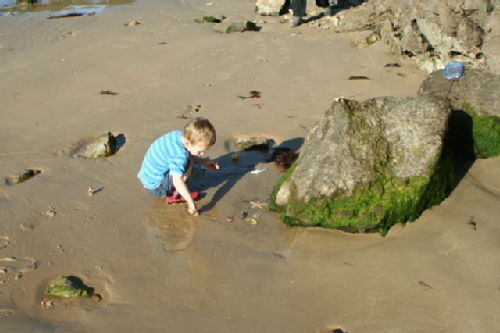
April 27, 2009
Asturias again
2 years ago, at Easter 2007, the pull of the south had been irresistible. We landed with two bikes at Santander, Morocco in our sights, sped down the Ruta de la Plata, but found our journey dissipated by the wonder that is rural Spain: icy mountains, golden eagles, vultures and strong sweet coffee.
Asturias, our first and last stop on that trip, had been a surprise. We camped at Arenas de Cabrales in the north of the Picos de Europa, alongside a wild river and snow covered mountains. I had never seen anything quite like it in Europe. And then we twisted over the top of the Peurto el Ponton.
But I had to return. This time no bike. But rather, a car, a wife and the boy. Would it work? Our first adventure in Europe....

Map from Google.

From Plymouth, the MV Pont-Aven sails: Brittany Ferries' finest cruise boat, complete with fancy restaurants, cinema, swimming pool...

...and children's play area...
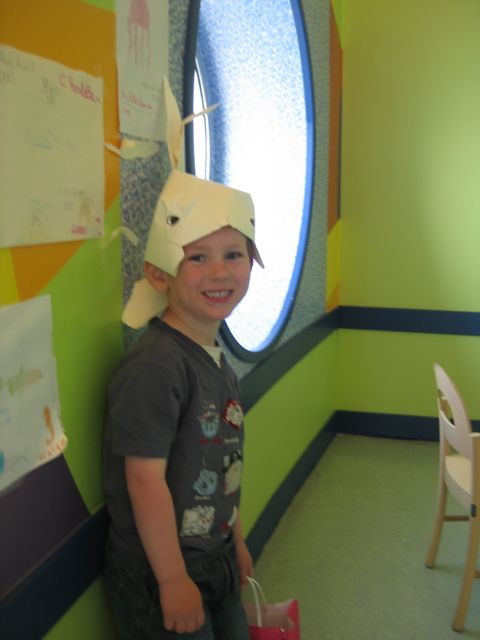
For Lawrence (3 1/2) the boat itself was great fun. The ship's resident wild-life officer ran sessions about whales and dolphins - that's a whale hat on his head.
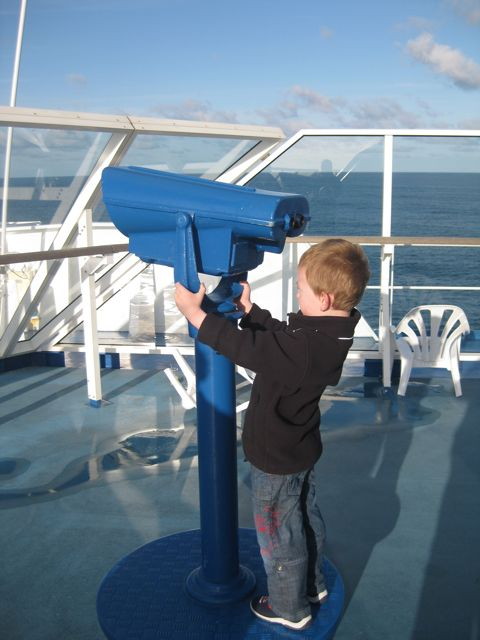
And he could safely walk about the deck of the boat in search of cetaceans.
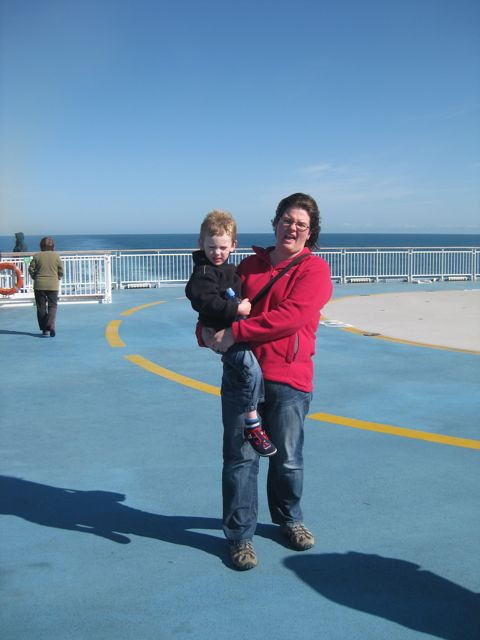
We slept over night in a small cabin. I took the upper bunk bed that Lawrence jealously coveted. And then in the morning the mountains appeared - "land ahoy" said Lawrence.
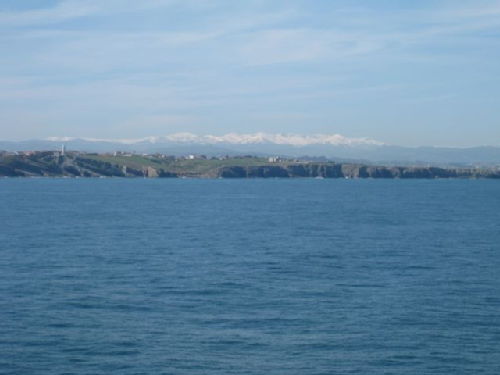
The route into Santander is spectacular in itself, famously running right next to a sandy beach on which people play.


Landing by ferry into the centre of a busy city is always an odd experience. We got out right away, looking for a quieter opportunity to acclimatise to the weather and the roads. As quickly as possible we were onto the coast road, stopping first at Santillana de la Mer, a touristic but still quiet town.

The museum was closed, as is usual in Spain on Monday. But the sculptures in front of it were of interest. The Asturians are fascinated with their paleolithic and neolithic past. Reminders of the long gone megafauna are everywhere - mammoths, rhinos, bison...

But it's the longer view that captures perfectly the modern day landscape...

After a light meal, we returned to the road, heading for a small spot at the end of a long beach.

The lagoon at Poo de Llanes, from Google Maps
March 19, 2009
No.1 Ladies' Opera House restaurant, Gaborone, Botswana
Follow-up to Botswana – yes, it really is quite like McCall Smith, Minghella and Curtis say it is from Transversality - Robert O'Toole
Lovely place. Out past Kgale Sidings, cows roaming around the street un-herded. If you're ever in Gabs and have a spare afternoon, try the seswaa pancakes - but watch out for bones! It's a really great dish, a unique flavour. I'm told that it's impossible to make outside of the Kalahari. Something to do with herbs that grow nowhere else in the world.

Lawrence loved playing in the cattle-trough turned water-feature...

And Mma Emma sat in the shade looking like a no.1 lady...

I'm told that they also sometimes do opera!
Botswana – yes, it really is quite like McCall Smith, Minghella and Curtis say it is
"Rose tinted view of Africa." - Kirsty Lang, Front Row today - SAID IT AGAIN!
Every review or article about the No.1 Ladies' Detective Agency TV shows expresses that same prejudice. "Surely Africa isn't like that". Richard Curtis tried his best to correct the misapprehension. He mentioned Comic Relief, and how some of the images of Africa that it portrayed may have left a lasting impression of the continent being all poverty and disease. Perhaps his work on the Lady Detective series will help us to forget those pictures.
But only if we can get this message across: Botswana really is a good, friendly, warm, cheerful place. And much of the rest of Africa is too.

Click image to enlarge
Lawrence playing detectives outside of the No. 1 Ladies Opera House, Gaborone
I've been visiting Gaborone every year since 1993. My wife grew up there. We were both amazed at how precisely the TV films represents Botswana and the Batswana (so far as TV can accurately represent anything). The detail is quite extraordinary - pictures on the wall that you would only ever see in Botswana, furniture, cars, buildings, the way in which people talk to each other, their facial expressions, the gay hairdresser - IN MY EXPERIENCE ALL MALE HAIRDRESSERS IN BOTSWANA ARE GAY! - or at least they pretend to be - the one's that I've met. And that's no problem, it's a tollerant and peaceful country.
Yes, it is true true that the films focus on certain areas and aspects of Gaborone life. But we aren't really interested in seeing the traffic jams on the Tlokweng Road or the massive high-tech shopping malls that have mushroomed in the last few years. But no TV film ever pretends to represent a whole country in one go.
MCall Smith, Minghella, Curtis - ke itumetse borra!
March 13, 2009
Deflated – TKC80 tyres on an R100GS need inner tubes!
Follow-up to Green laning on an R100GS with Continental TKC80 tyres from Transversality - Robert O'Toole
"Tubeless".
That's what it says on the side of the Continental TKC80 tyres now fitted to my BMW R100GS Paris Dakar. One would assume that means "don't use an inner tube". I made that assumption. So did the tyre fitter. The fitment guide on the Continental web site has quite a different interpretation of the word:

The fitment info even states which tubes to use.
Perhaps this little misunderstanding explains why my tyres were completely flat this morning. It could be that TKC80s aren't sufficiently rigid at the bead to give a good enough seal. Or perhaps the first generation Akront tubeless spoked rims are a bit too leaky (Metzelers also deflate, but much more slowly).
So its back to Behind Bars in the week to get some tubes fitted.
It didn't stop me going for a ride out to Stoneleigh on the way home, with a quick bimble down a green lane. Mud, mud, glorious mud.
 Robert O'Toole
Robert O'Toole

 Please wait - comments are loading
Please wait - comments are loading
